Risks of shallow, unanchored artificial reefs
Moderators: CaptPatrick, mike ohlstein, Bruce
-
Rickiratardo
- Posts: 11
- Joined: Jan 11th, '10, 19:58
Risks of shallow, unanchored artificial reefs
Ok here is what I was saying about the risks of building artificial reefs from vessels and barges and subway cars and stuff like that. The experts agree that this stuff won’t stay were you put it because it offers a resistant side to the ocean currents and gets tossed all over the place when a storm churns the bottom. If you put it in 60 feet there is nothing to stop it from tumbling into 30 feet, or from turning or stacking so that a part of it could be sticking up when an unsuspecting yacht passes by.
The experts recommend putting sunken debris that is not specially designed for artificial reefs – like they do in Japan-- in deep water, deeper than 90 feet-- and even at that, they recommend that the ship or barge or subway car be anchored because they tend to wander. The Carolinas build artificial reefs, yachtsmen ought to know in 60 feet and some times in 30 feet.
I got into this when the Key Largo part of the Florida Keys Artificial Reef Association got a permit to sink the Spiegle Grove just east of the very healthy reef. I warned them when I was editor of The Boating News to anchor that ship so it could not tumble and crush the reef. They ignored me (even tho I am founder and first president of the FKARA with some knowledge of this stuff.) And sure enough in July 2005 a small storm blew this 510 foot long ship over and toward the reef.
Storm uprights Spiegel Grove!
July 2005 - Underwater turbulence generated by Hurricane Dennis has uprighted the 510-foot artificial reef known as the Spiegel Grove.
The Florida Keys National Marine Sanctuary is working on an emergency closure of the site while it assesses the ship's stability and its general condition. Workers will be removing the mooring buoys temporarily, sanctuary spokeswoman Cheva Heck said.
The shifted position of the 510-foot ship comes as a surprise because the area experienced minimal tropical-storm force winds during the passage of Hurricane Dennis on Saturday.
On Monday, a boat from Key Largo dive shop Ocean Divers visited the former Navy ship, which was scuttled in 130 feet of water May 17, 2002. When divers arrived at the site six miles offshore, they saw that several mooring balls were missing.
Here are a few more:
During Hurricane Andrew all the steel ships off Dade County endured tremendous movement and/or damage. But Andrew came ashore as a small intense storm across lower Biscayne Bay. Meanwhile more than 80 miles north:
“at least one vessel was moved offsite, four were laid over on their sides, and wrecks in water as deep as 180 feet experienced hull damage.
The hulls of the steel freighters Mercedes (250 feet in length in 97 feet of water) and the Noula Express (220 feet in length in 90 feet of water) were both broken in three places. A light gauge metal yacht in 65 feet of water was reduced to rubble.
There was evidence that shipwreck reefs were literally bounced up and down against the bottom (Ken Banks, personal communication).â€
The experts argue that shallow reefs for fishermen and divers often due more harm than good because the only good they do is to create a place for fishermen to lose their terminal tackle. Nobody has studied using a fiberglass boat for an artificial reef because the steel ones don’t last very long, and the idea of a fiberglass boat as a reef is laughable among reef builders.
Hurricane Hugo (1989), like Hurricane Andrew, which had sustained winds exceeding 150 miles per hour, bounced a 450 foot long troop ship, sunk off South Carolina 700 feet laterally across the bottom.â€
Don't take my word for it, All of this and much more is available from this source:
GUIDELINES FOR MARINE ARTIFICIAL REEF MATERIALS
Second Edition
Compiled by the
Artificial Reef Subcommittees of the Atlantic and Gulf States Marine Fisheries Commissions
Ronald R. Lukens and Carrie Selberg
Project Coordinators
January 2004
This project was conducted in cooperation with the U.S. Fish and Wildlife Service and funded by Federal Aid in Sport Fish Restoration Administrative Funds, FWS Grant Agreement Nos. GS96
Amendment 7, A-4-1 and A-5-1. Support was also provided through the Atlantic Coastal Fisheries Cooperative Management Act NA17FG2205 and NA03NMF4740078
The experts recommend putting sunken debris that is not specially designed for artificial reefs – like they do in Japan-- in deep water, deeper than 90 feet-- and even at that, they recommend that the ship or barge or subway car be anchored because they tend to wander. The Carolinas build artificial reefs, yachtsmen ought to know in 60 feet and some times in 30 feet.
I got into this when the Key Largo part of the Florida Keys Artificial Reef Association got a permit to sink the Spiegle Grove just east of the very healthy reef. I warned them when I was editor of The Boating News to anchor that ship so it could not tumble and crush the reef. They ignored me (even tho I am founder and first president of the FKARA with some knowledge of this stuff.) And sure enough in July 2005 a small storm blew this 510 foot long ship over and toward the reef.
Storm uprights Spiegel Grove!
July 2005 - Underwater turbulence generated by Hurricane Dennis has uprighted the 510-foot artificial reef known as the Spiegel Grove.
The Florida Keys National Marine Sanctuary is working on an emergency closure of the site while it assesses the ship's stability and its general condition. Workers will be removing the mooring buoys temporarily, sanctuary spokeswoman Cheva Heck said.
The shifted position of the 510-foot ship comes as a surprise because the area experienced minimal tropical-storm force winds during the passage of Hurricane Dennis on Saturday.
On Monday, a boat from Key Largo dive shop Ocean Divers visited the former Navy ship, which was scuttled in 130 feet of water May 17, 2002. When divers arrived at the site six miles offshore, they saw that several mooring balls were missing.
Here are a few more:
During Hurricane Andrew all the steel ships off Dade County endured tremendous movement and/or damage. But Andrew came ashore as a small intense storm across lower Biscayne Bay. Meanwhile more than 80 miles north:
“at least one vessel was moved offsite, four were laid over on their sides, and wrecks in water as deep as 180 feet experienced hull damage.
The hulls of the steel freighters Mercedes (250 feet in length in 97 feet of water) and the Noula Express (220 feet in length in 90 feet of water) were both broken in three places. A light gauge metal yacht in 65 feet of water was reduced to rubble.
There was evidence that shipwreck reefs were literally bounced up and down against the bottom (Ken Banks, personal communication).â€
The experts argue that shallow reefs for fishermen and divers often due more harm than good because the only good they do is to create a place for fishermen to lose their terminal tackle. Nobody has studied using a fiberglass boat for an artificial reef because the steel ones don’t last very long, and the idea of a fiberglass boat as a reef is laughable among reef builders.
Hurricane Hugo (1989), like Hurricane Andrew, which had sustained winds exceeding 150 miles per hour, bounced a 450 foot long troop ship, sunk off South Carolina 700 feet laterally across the bottom.â€
Don't take my word for it, All of this and much more is available from this source:
GUIDELINES FOR MARINE ARTIFICIAL REEF MATERIALS
Second Edition
Compiled by the
Artificial Reef Subcommittees of the Atlantic and Gulf States Marine Fisheries Commissions
Ronald R. Lukens and Carrie Selberg
Project Coordinators
January 2004
This project was conducted in cooperation with the U.S. Fish and Wildlife Service and funded by Federal Aid in Sport Fish Restoration Administrative Funds, FWS Grant Agreement Nos. GS96
Amendment 7, A-4-1 and A-5-1. Support was also provided through the Atlantic Coastal Fisheries Cooperative Management Act NA17FG2205 and NA03NMF4740078
Former editor Southern Boating, Florida Shipper,The Boating News
GUIDELINES FOR MARINE ARTIFICIAL REEF MATERIALS
A bit too much reading for me...but I get the drift (pun intended)
I never really thought about artificial reefs moving. Figured when they where down in a location, they stayed. It really becomes something you have to consider when traveling in close proximity.
Thanks for the info,
Carl
A bit too much reading for me...but I get the drift (pun intended)
I never really thought about artificial reefs moving. Figured when they where down in a location, they stayed. It really becomes something you have to consider when traveling in close proximity.
Thanks for the info,
Carl
-
Rickiratardo
- Posts: 11
- Joined: Jan 11th, '10, 19:58
I think it was Hurricane Georges in '98... Took the wreck of the Eagle (small freighter in 110' off Islamorada) and literally broke the hull in two pieces.
Anyone who scuba dives, think of the powers of surge on a normal day... especially in a shoaling area like a reef slope. Then think about it during a tropical storm, or a full on hurricane. Serious forces at work there.
I don't think it holds any water, or relevance to the "you know what" issue however.
Anyone who scuba dives, think of the powers of surge on a normal day... especially in a shoaling area like a reef slope. Then think about it during a tropical storm, or a full on hurricane. Serious forces at work there.
I don't think it holds any water, or relevance to the "you know what" issue however.
I don't know what the world may want,
But a good stiff drink it surely dont,
Think I'll go and fix myself...a tall one.
But a good stiff drink it surely dont,
Think I'll go and fix myself...a tall one.
-
Rickiratardo
- Posts: 11
- Joined: Jan 11th, '10, 19:58
Buju
I shoulda mentioned that these impermanent ship and train car shallow reefs are great for divers, not just anglers. As long as they don't wander into unexpected places.
I still say they are best for everybody when they are properly secured, then you can safely stack them for best relief and not risk hazards to navigation. But securing them does make them more expensive.
As to you know what, it will be interesting to see what is left the next time somebody dives those shallow Carolina reefs. Been a couple nice nor'easters thu there this winter.
I shoulda mentioned that these impermanent ship and train car shallow reefs are great for divers, not just anglers. As long as they don't wander into unexpected places.
I still say they are best for everybody when they are properly secured, then you can safely stack them for best relief and not risk hazards to navigation. But securing them does make them more expensive.
As to you know what, it will be interesting to see what is left the next time somebody dives those shallow Carolina reefs. Been a couple nice nor'easters thu there this winter.
Former editor Southern Boating, Florida Shipper,The Boating News
Here are a couple of photos of some 800 ton concrete ship mooring anchors we are removing from the Corpus Christi Ship Channel, We are cutting them into 50 ton blocks they will then be transported by barge 25 miles offshore to Matagorda Disposal Site 7 off the Texas Coast - water depth is 135 feet, Our disposal plan does not include anchors. (date on photo is wrong by 3 years) We will be begin dumping of the blocks in March of this year, I will post some more photos of the dumping.
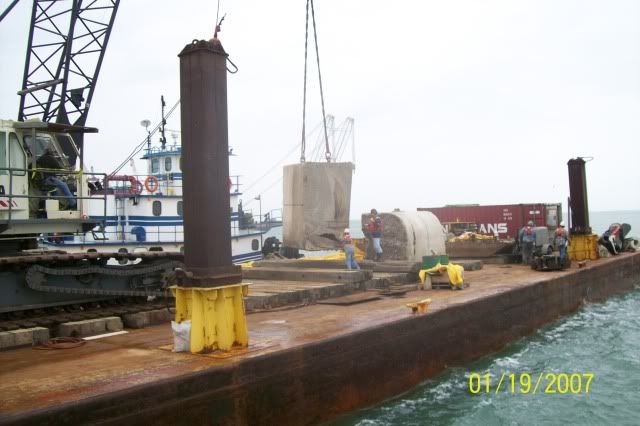
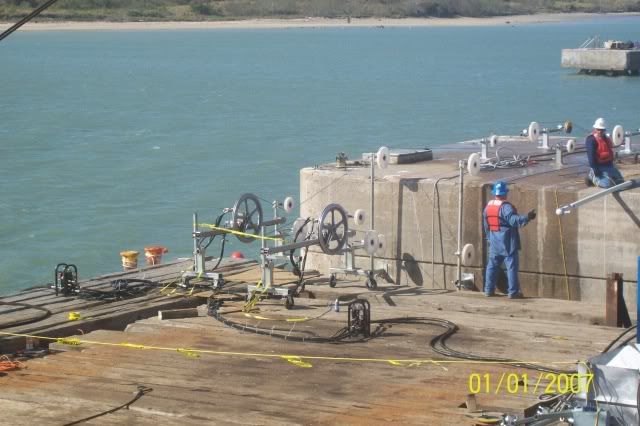




-
Rickiratardo
- Posts: 11
- Joined: Jan 11th, '10, 19:58
Wow. Now that is the way to put down a permanent fish attractor. Congratulations. Hope you come back with the numbers.
The reefs we built when I was involved with the Florida Keys Artifical Reef Association were primarily concrete hunks of the old Keys bridges. The head boats still can make their day on those.
The reefs we built when I was involved with the Florida Keys Artifical Reef Association were primarily concrete hunks of the old Keys bridges. The head boats still can make their day on those.
Former editor Southern Boating, Florida Shipper,The Boating News
a couple of shots of the wire saws at work, large moorings were 30x32x10 feet they were sectioned into 20 pcs. each cut takes about 16 hours - six 800 ton blocks and nine 200 ton blocks plus all of the piling that supported them. Wire is 3/8 diamond ring with spring backers, saw motors are 40 hp hydraulic. Crane is 225 ton American on a 150x50x8 spud barge. 3 inch drop in wedge anchors with 3 inch eye nuts, 7/8 6 braid slings with 2 7/8 crosby shackels for lifting the blocks - 5 to one safety factor on all rigging and 3 to one on crane.
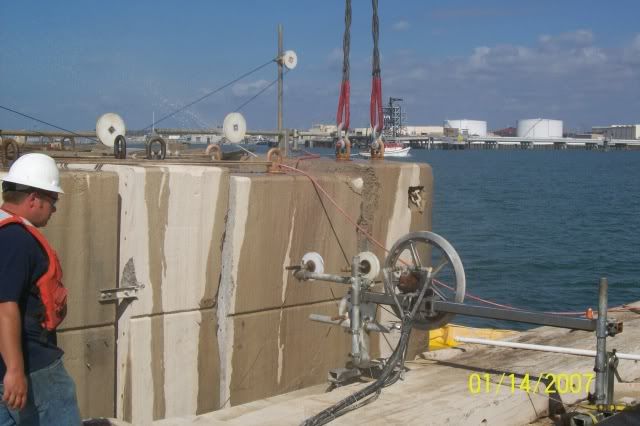
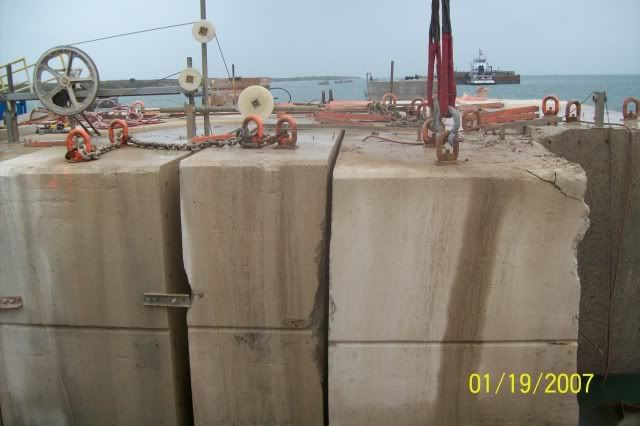
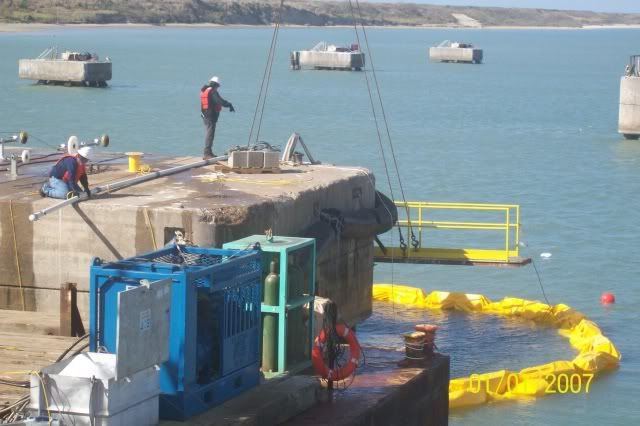



-
Rickiratardo
- Posts: 11
- Joined: Jan 11th, '10, 19:58
Clay
Coupla things to keep in mind when it comes time to sinking those huge lumps. Stability! With a crane on board the barge has a high risk of instability as the load is reduced and deposited.
Wait for perfect weather and unload the barge from a seperate, rafted crane -- either on a seperate stable barge or a strong crane on a small cargo vessel.
The hardest part, and another reason why you need calm weather, is station-keeping. If you have a limited permit zone, you can be liable for dropping beyond its dimensions.
When in doubt, first get an option to expand the permitted drop zone.
Coupla things to keep in mind when it comes time to sinking those huge lumps. Stability! With a crane on board the barge has a high risk of instability as the load is reduced and deposited.
Wait for perfect weather and unload the barge from a seperate, rafted crane -- either on a seperate stable barge or a strong crane on a small cargo vessel.
The hardest part, and another reason why you need calm weather, is station-keeping. If you have a limited permit zone, you can be liable for dropping beyond its dimensions.
When in doubt, first get an option to expand the permitted drop zone.
Former editor Southern Boating, Florida Shipper,The Boating News
This is a follow up on building an artifical reef, Here are a couple of videos of us dumping the concrete blocks from an Ocean Going Barge 22 miles off the coast of Texas at Matagorda Reef site 712
FYI - BP and the Federal Government did not do any engineering or design work on the lever that created the incline plane that made dumping 78,000 to 126,000 blocks overboard possible. And because of this it worked like a charm and 184 blocks are now sitting in 130 feet of water.
http://www.youtube.com/watch?v=Iiqy9E4tYmU
http://www.youtube.com/watch?v=ILOJPqAtL9c
http://www.youtube.com/watch?v=bRBzaDc6Vfk
http://www.youtube.com/watch?v=wmmH3xkPv68
CLay
FYI - BP and the Federal Government did not do any engineering or design work on the lever that created the incline plane that made dumping 78,000 to 126,000 blocks overboard possible. And because of this it worked like a charm and 184 blocks are now sitting in 130 feet of water.
http://www.youtube.com/watch?v=Iiqy9E4tYmU
http://www.youtube.com/watch?v=ILOJPqAtL9c
http://www.youtube.com/watch?v=bRBzaDc6Vfk
http://www.youtube.com/watch?v=wmmH3xkPv68
CLay
Who is online
Users browsing this forum: Google [Bot] and 6 guests